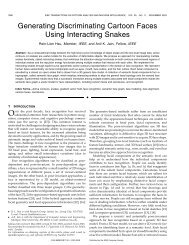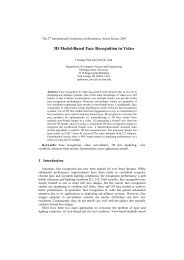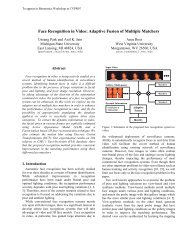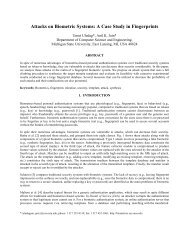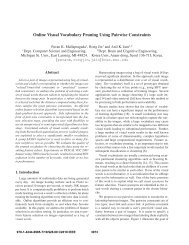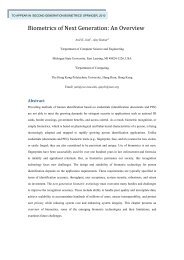Face Detection and Modeling for Recognition - Biometrics Research ...
Face Detection and Modeling for Recognition - Biometrics Research ...
Face Detection and Modeling for Recognition - Biometrics Research ...
You also want an ePaper? Increase the reach of your titles
YUMPU automatically turns print PDFs into web optimized ePapers that Google loves.
oundary.<br />
A face score is computed <strong>for</strong> each set of eyes, mouth <strong>and</strong> the ellipse.<br />
Figure 3.1 shows a detected face <strong>and</strong> the enclosing ellipse with its associated eyemouth<br />
triangle which has the highest score that exceeds a threshold. These detected<br />
facial features are grouped into a structured facial descriptor in the <strong>for</strong>m of a 2D<br />
graph <strong>for</strong> face description. These descriptors can be the input to subsequent modules<br />
such as face modeling <strong>and</strong> recognition.<br />
We now describe in detail the individual<br />
components of the face detection algorithm.<br />
3.2 Lighting Compensation <strong>and</strong> Skin Tone<br />
<strong>Detection</strong><br />
The appearance of the skin-tone color can change due to different lighting conditions.<br />
We introduce a lighting compensation technique that uses “reference white” to normalize<br />
the color appearance. We regard pixels with the top 5% of the luma (nonlinear<br />
gamma-corrected luminance) values as the reference white if the number of these pixels<br />
is sufficiently large (> 100). The red, green, <strong>and</strong> blue components of a color image<br />
are adjusted so that these reference-white pixels are scaled to the gray level of 255.<br />
The color components are unaltered if a sufficient number of reference-white pixels<br />
is not detected. This assumption is reasonable not only because an image usually<br />
contains “real white” (i.e., white reference in [155]) pixels in some regions of interest<br />
(such as eye regions), but also because the dominant bias color always appears in<br />
the “real white”. Figure 3.2 demonstrates an example of our lighting compensation<br />
61



